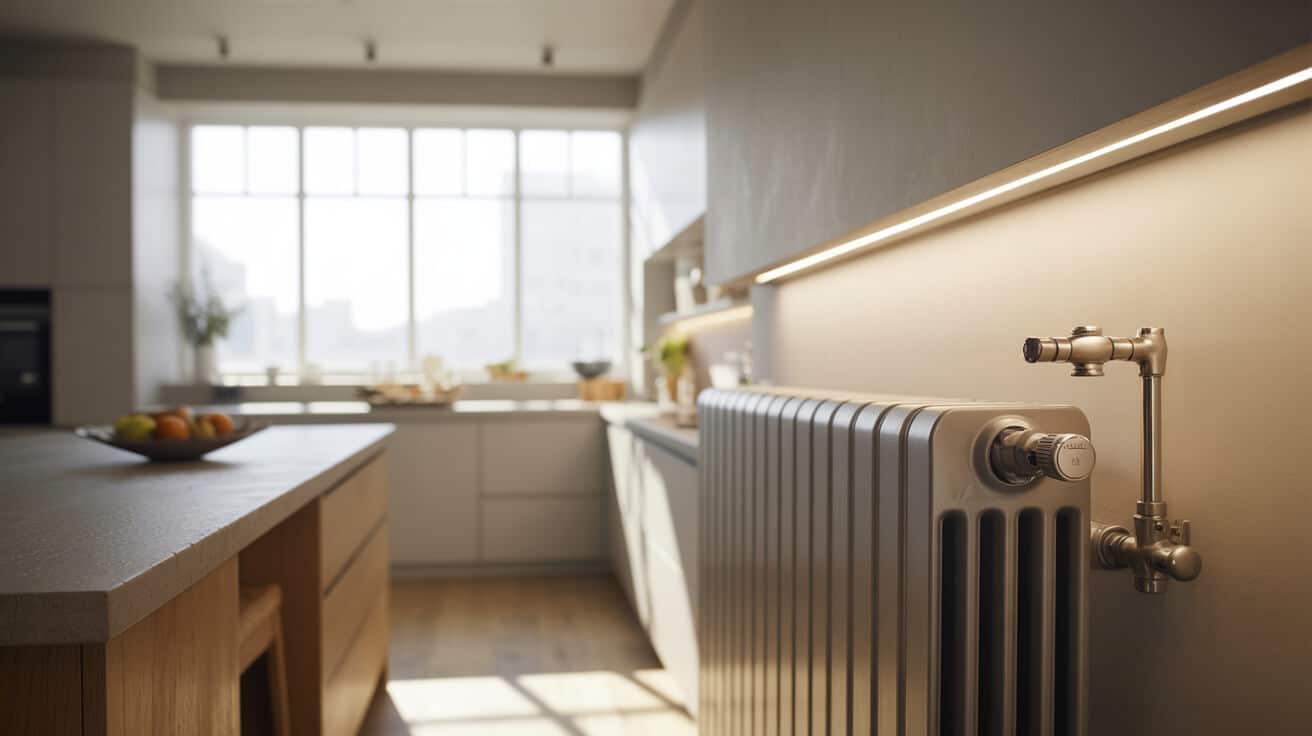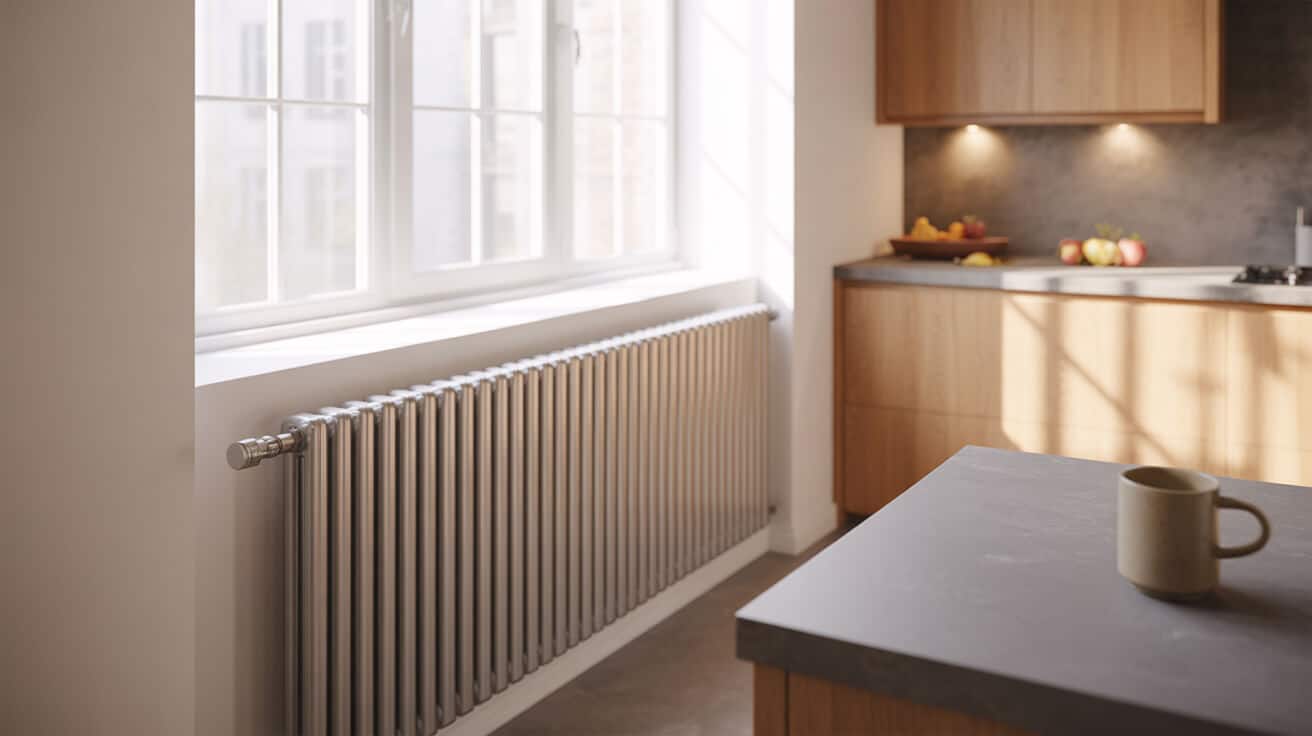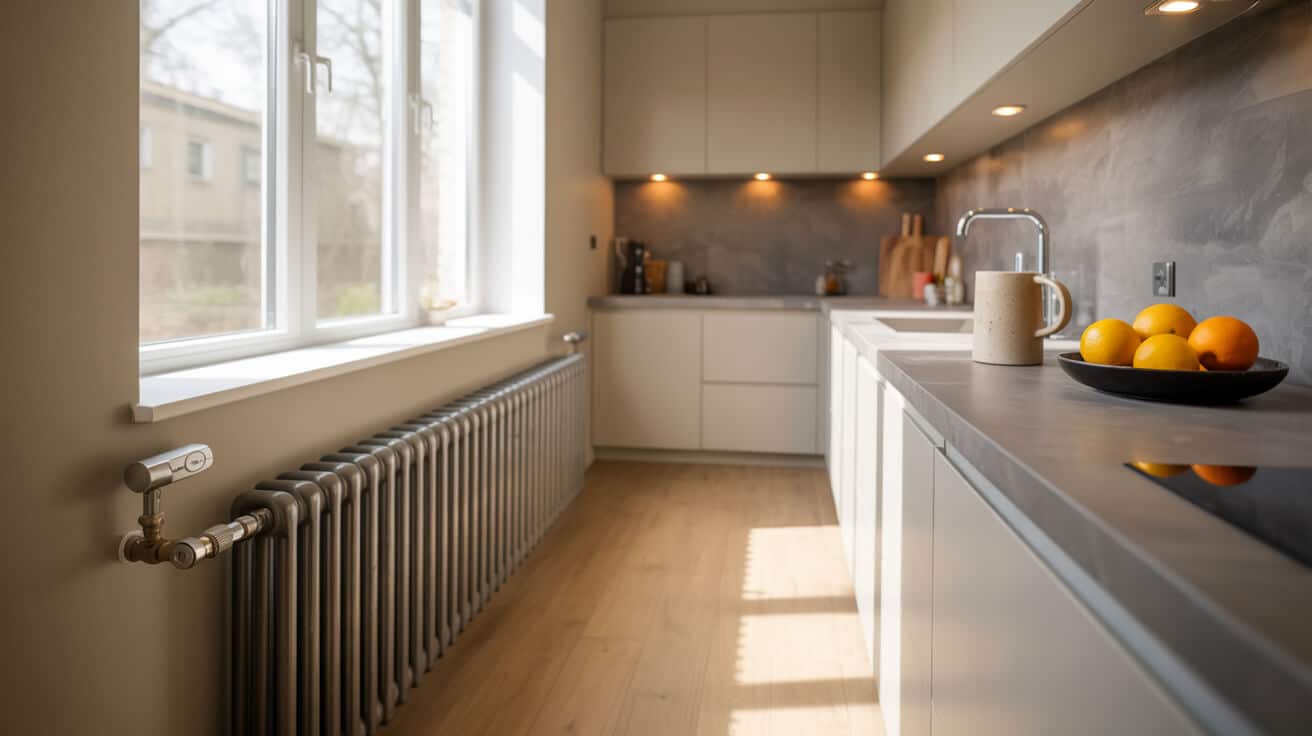Hydronic radiators function as distributed endpoints in a pressurised or open-circuit network, converting stored or on-demand thermal energy into localised heat through conduction and convection. Your property’s interior comfort, energy management, and compliance standards are closely linked to the design and condition of its radiator infrastructure. A modern installation process spans heat loss analysis, selection of appropriately sized and styled radiators, integration with valve and control technologies, and the performance of commissioning and regulatory documentation procedures. These services adapt to your company’s unique building type, occupancy needs, regulatory context, and lifecycle maintenance priorities.
Etymology or name origin
The term “radiator” originates from the Latin radiare, meaning “to emit rays,” which reflects a device’s original design purpose to radiate thermal energy. Early heating discourse differentiated between “radiators” (devices using radiant heat) and “convectors” (systems optimising convection), with legacy terminology now repurposed for technical, regulatory, and aesthetic categorization. Contemporary professional parlance incorporates derivatives such as “TRV” (thermostatic radiator valve), “lockshield,” and “panel,” which denote component specialisation, control logic, or manufacturing process.
Overview / context
Radiator-based heating has been central to the evolution of interior thermal management, contributing to health, comfort, and the value of your real estate assets. Systems scale from single-room upgrades to multi-site, digitally managed estates, aligning with broader goals such as improved EPC rating, landlord legal compliance, and public health regulation adherence. Your organisation’s ability to deliver economic value, tenant comfort, and sustainability metrics is often directly mediated through radiator network configuration, zoning, and service reliability. Plumbing and heating companies such as Plumbers 4U enable seamless integration of radiator systems with broader mechanical and digital controls, providing tailored solutions for every stage of the asset lifecycle.
History
Origins
The advent of hydronic heating can be traced to 19th-century industrial and urban expansion, where repeated technological advances in ironworking, pipe manufacture, and boiler engineering facilitated widespread uptake in public buildings and upper-class residences. Early radiator installations leveraged gravity-fed, open-circuit designs, with heavy cast-iron columns or coils distributed for robust, if imprecise, heat transfer.
Industrial emergence
After the Victorian era, demand for scalable, cost-effective heating led to the proliferation of wall-mounted, steel panel radiators, together with improved pipe insulation, thermostatic valves, and networked controls. Installations matured in complexity, incorporating multi-zone distribution and higher levels of regulatory oversight for safety and efficiency.
Contemporary evolution
From the 1970s onward, the discipline diversified: energy crises, building regulation reforms, and digital innovation drove the transition to modular, high-efficiency, and user-adaptive radiator systems. Platforms now routinely integrate smart thermostats, open-protocol controls, and predictive maintenance analytics, while product design reflects mounting safety, accessibility, and sustainability standards present in landlord, commercial, and institutional property management.

Concept / description
Principles of hydronic heat delivery
Radiators transfer energy via heated water or glycol circulated by pumps or combi boilers, leveraging convection and, to a lesser degree, radiant output. Heat loss calculation informs the optimal unit size and flow rate for your space, considering insulation, window area, and room use. Supply and return pipes, constructed from materials such as copper, PEX, or steel, form the backbone of the distribution network, often zoned by programmable valves or smart actuators.
Radiator structure and role
Panels present expansive surfaces to be efficiently traversed by air, while columns and designer radiators emphasise higher thermal mass and aesthetic integration. TRVs allow each unit to modulate output relative to your dynamic temperature requirements, and lockshield or bypass valves protect circuit pressure and balance. As integral nodes within closed-loop systems, radiators underpin both localised comfort and aggregate building energy modelling.
Ancillary and safety elements
system efficiency and reliability depend upon precise wall or floor mounting, pipe insulation, corrosion-resistant materials, inhibitor dosing, and air removal (bleeding). Automated, digital, or remote diagnosis tools are increasingly prevalent within property maintenance workflows to reduce unplanned downtime and extend system lifecycle.
Functionality / purpose / applications
Radiators serve to regulate thermal comfort, safeguard assets against condensation and freeze events, and support statutory compliance across your properties. In domestic settings, radiator heating enables tailored zoning and cost-effective upgrades to new builds, loft conversions, and heritage refurbishments. For landlords and agents, precisely specified installations reduce legal exposure, enhance marketability, and facilitate rapid, low-disruption repairs. In commercial buildings, radiators interface with building management systems (BMS) for seamless scheduling, monitoring, and remote adjustment, supporting health and safety policy, insurance acceptance, and long-term sustainability goals. Retrofit strategies, central to decarbonization roadmaps, often focus on staged replacement, pipe rerouting, and minimal-occupant disruption to accommodate enhanced controls, low-temperature sources, and improved EPC ratings.
Classifications / types / variants
Radiator archetypes
- Panel radiators: Flat, single, or double-panel construction (conventional in new builds and mass-market installations).
- Column radiators: Multi-tube forms yielding higher thermal mass and decorative accent for period or boutique properties.
- Designer/convector models: Architecturally integrated or shaped for specialty applications; include finned or louvred variants for improved convection.
- Towel rails: Heated racks, common in bathrooms, that also provide room warming and humidity management.
- Low surface temperature units: Designed for high touch environments, such as childcare or elder care settings.
- Electric and dual-fuel radiators: Used in off-grid, all-electric, or zoned/supplementary serving scenarios.
Material and finish matrix
| Type | Typical Material | Attributes | Use Cases |
|---|---|---|---|
| Panel | Steel | Durable, easy to manufacture | Standard homes, offices |
| Column | Steel/Cast iron | High mass, classic look, slow heat/cool | Heritage/rental stock, hospitality |
| Designer | Steel/Aluminium | High aesthetic, varied finish | Premium, visible installations |
| Towel rail | Steel/Chrome | Compact, corrosion resistant, dual function | Washrooms, wet environments |
| Electric/Dual-fuel | Steel/Aluminium | Fast response; supplements hydronic network | Remote rooms, secondary systems |
Standards and innovations
Manufacturers tailor size, shape, and coating to regulatory domains and energy reporting requirements, with magnetic philtre compatibility, anti-limescale treatments, and modularity for smart control a focus in new developments.
Systems / tools / methodologies
Survey and system assessment
Your property’s recommendation journey always begins with detailed survey and thermal performance analysis. Floor area, room volume, occupancy profile, and external factors govern heat loss, feeding into BTU or kilowattage models that inform precise equipment selection. Digital diagnostics, from thermal imaging to in-line water testing, complement visual site assessments.
Installation and connection tools
- Pipe cutters and benders for copper/PEX
- Power presses for jointing
- Spirit levels, stud finders, and reinforcement hardware for stable mounting
- Insulation, pipe lagging, sealants for long-term performance
- Bleed keys and pressure gauges for system balancing
Commissioning and balancing
Proper system operation is achieved through sequential filling, air purging, inhibitor dosing, and pressure testing procedures, followed by iterative valve adjustment for optimal flow and balanced distribution. Your service provider may also deploy flush and magnetic filtration equipment to prevent legacy system contamination.
Maintenance suites
Routine aftercare includes water quality testing, inhibitor replenishment, valve swaps, and smart controller firmware updates. Annual or seasonal reviews, commonly managed by organisations like Plumbers 4U, are pivotal for warranty retention and early detection of faults.

Stakeholders / entities involved
Homeowners
Your direct involvement spans solution research, interface customization, and ongoing comfort and economy feedback. Choice is often influenced by property size, age, insulation, and intended room use.
Landlords and letting agents
Your needs focus on scalable compliance, low-maintenance tenancy, and service interval planning. Regulatory documentation, safety checks, and EPC optimization are routine priorities.
Facilities/property managers
Estate-wide specifications, incident response, and forecasted renewal schedules are managed with a focus on downtime minimization and budgetary control.
Heating engineers/contractors
Technical implementation, adaptation to building constraints, and compliance with installation best practices and manufacturer protocol are core. Your coordination with manufacturers, architects, and clients determines project success.
Manufacturers, suppliers, regulatory bodies
Brands must adapt product lines to legislative trends and emerging customer preferences. Industry bodies define and update technical and safety standards, ensuring your network can access compliant, efficient, and durable components.
Legal / regulatory / ethical considerations
Regulatory landscape
- Building Regulations Part L (UK): Requires minimum thermal efficiency for all space heating installations; supports the decarbonization strategy in new and existing buildings.
- WRAS approval: Ensures the use of materials and designs that protect potable water supplies.
- Boiler Plus: Enforces the use of programmable timers, temperature controls, and additional energy efficiency measures for all relevant systems.
- BS EN 442: Mandates standardised performance and safety labelling for manufactured radiators and convectors.
- Landlord compliance: Safety certification intervals for tenanted or multi-user buildings; full documentation of installations and upgrades.
Ethical practice and safety
Responsible implementation encompasses safe isolation, manual handling techniques, COSHH-compliant chemical use, and responsible legacy-equipment disposal. Warranties and manufacturer guarantees hinge upon documentation of correct procedure and maintenance over time.
Performance metrics / data / measurements
Output, balance, and efficiency
- BTU/kW rating: Directly correlated with room volume, insulation, and exposure.
- System balance: Achieved through iterative adjustment, maximising comfort, minimising local over/underheating, and supporting boiler efficiency.
- Operational lifespan: Typical radiators last from 10 to 25 years, depending on build quality, environment, and maintenance schedule.
Maintenance and reporting
Routine checks support warranty retention and system performance. Digital thermostats and modern controls often report energy usage, system faults, and predictive maintenance needs, aligning operational data with your financial and regulatory reporting cycles.
| Metric | Standard Measure | Impact |
|---|---|---|
| Heat Output | BTU/hr or kW | Comfort, compliance |
| System Pressure | Bar/PSI | Safety, performance |
| Efficiency Score (EPC) | A–G | Market, compliance, cost |
| Warranty Duration | Years | Asset lifecycle, financial |
| Service Interval | Months/years | Compliance, risk management |
Challenges / barriers / limitations
Technical and operational
- Legacy pipework, spatial constraints, insufficient flow, or aged infrastructure can limit the upgrade or retrofit path in your organisation’s portfolio.
- Inaccurate sizing, system imbalance, or insufficient valve control results in cold spots, inefficiency, and user dissatisfaction.
- Heritage or protected buildings require non-standard mounting, specialised materials, or hidden services implementation.
Social and economic
- Installation projects may necessitate vacancy or restricted access, carry significant direct costs, and occasionally interact with health, safety, or business interruption insurance endorsements.
- Behavioural factors—such as tenant use patterns, maintenance deferral, or unauthorised change—can impact operational reliability.
Policy and perception
Balancing short- and long-term investment—immediate retrofit cost versus sustainability goals—remains a persistent driver of decision-making in both residential and commercial property development.
Impact / influence / legacy
The widespread adoption of radiator-based heating shaped building design, public health, and energy consumption patterns in the modern era. Systematic upgrades, zoning strategies, and efficiency standards underpin broader transitions toward net zero emissions, stringent EPC compliance, and higher living and working standards. The ongoing influence of materials science, digital integration, and social housing policy is reflected in continuous improvement cycles across all building segments.
Future directions, cultural relevance, and design discourse
Emerging trajectories include the fusion of heating appliances with architectural, digital, and environmental systems. smart controls, adaptive zoning, predictive algorithms, and rapid retrofitting align with net-zero ambitions and legislative momentum. Your organisation’s future asset planning will increasingly prioritise modularity, multi-vector energy inputs, and comfort analytics. Design innovation situates radiators as both utility and focal element, reflecting the intersection of cultural symbolism, occupant demand, and responsible resource use. Environmental performance, health optimization, and policy alignment are expected to form the next vanguard of heating solution design, specification, and operation.

